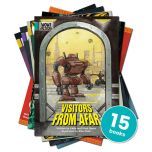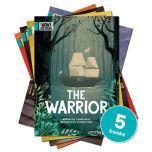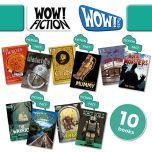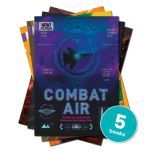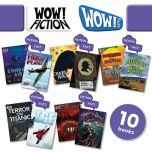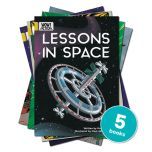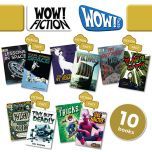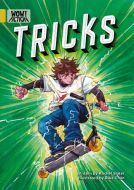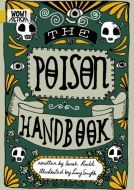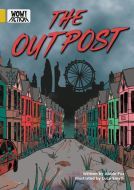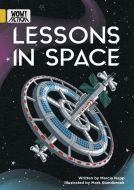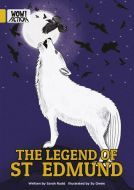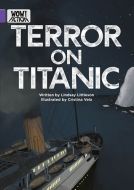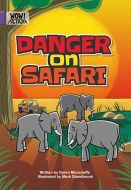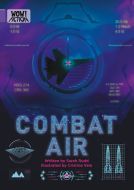WOW! Fiction: New Progressively Levelled Series
WOW! Fiction is a brand-new, progressively levelled series of short, gripping and fast-paced stories which will captivate readers. The dyslexia-friendly design incorporates features such as super-readable fonts, clear line spacing, off-white backgrounds and bite-sized chunks of text to ensure success and build reading confidence. We offer five books at each level, allowing students to practice and consolidate their skills before moving on to more challenging texts or alternatively, they can choose freely within the range. We offer books at turquoise, purple and gold levels (reading ages 6–6.5) with an interest age of 9–14.
WOW! Fiction follows on from our best-selling WOW! Facts series and each book can be paired with a non-fiction counterpart on the same theme, such as Exploring Space, Ancient Egypt or Fighter Planes. Some students may want to learn more about a topic, and we’ve ensured that they can access a non-fiction book at the same level, providing an opportunity to experience different text types and formats.
Why should I use WOW! Fiction in my library/classroom?
The need for low-level texts suitable for UKS2/KS3 children is paramount, as a third of pupils going into Year 7 are behind in their reading.
- They are hi-lo — Suitable age-appropriate themes, illustrations, and storylines appeal to older children. At the same time, the simplicity of the text and the use of accessible features such as dyslexia-friendly fonts, text formatting, and thicker, coloured paper ensure successful reading experiences. The Reading Framework (Department for Education July 2023) recommends hi-lo books:
‘Hi-lo’ books provide high interest content at an easy reading level: histories of famous people, books about underwater life, biographies, semi-fictional stories based on real events and so on. Pupils can accumulate background knowledge across the whole curriculum, learning a lot about a little under the radar of easy reading. These books, along with easy-read page-turners, not only provide immediate engagement, but also lead towards the pleasure of reading more challenging books in English lessons and in other subjects.’
The Reading Framework outlines that they can have wider appeal in the school too:
‘short ‘hi-lo’ non-fiction (can be read by young readers or older readers who need extra practice) longer hi-lo fiction (can be read by young, advanced readers or older readers)..
- They are progressively levelled — With five books at each level, there is plenty of practice for pupils who may need it before moving on. Both teachers and students can see the progression of their reading skills as they make their way through the levels, giving a sense of achievement. All books have been levelled by an educational consultant to ensure that the vocabulary and sentence structures are suitable for the reader.
- They link to non-fiction — each book links to a non-fiction title from our WOW! Facts series, bringing to life a subject that may be covered in class or explored in book discussions.
- They include activities — each book contains six comprehension questions and a literacy activity, such as a diary entry or newspaper report, to link to writing. They also include a cross-curricular activity to build independent learning skills.
Which design features of WOW! Fiction help dyslexic and neurodiverse readers?
The best books for dyslexic readers feature specific layout aspects to help the reader decipher the text. Many elements of dyslexia-friendly design are incorporated in the creation of the WOW! Fiction series following guidelines advised by the British Dyslexia Association.
- Text — the Opendyslexic font was specifically created to help dyslexic readers untangle the words on the page. The weighting and shape of every letter help to differentiate them from each other — for example, d and b. Size 12 font ensures the text is large enough to be legible. Text is always placed on a plain, single-colour background and not over the top of images.
- Paper — the paper thickness is 150 gsm to avoid show-through from other pages, which can cause interference or distraction. The cream-coloured matte paper reduces glare, as white can appear too dazzling for sensitive eyes.
- Formatting — the text is left aligned to ensure spacing is even between words, and we do not use indents. Both help the reader keep their place when reading. Extra line spacing and wide margins ensure plenty of white space on a page, so the pages do not feel too cluttered.
- Length — WOW! Fiction titles are all short reads, ensuring that students who don’t have reading stamina (this may include neurodiverse students) can read whole chapters and uncover more of the story before taking a break. The low word count also means that the gratification and reward from finishing a book come much quicker than when reading a traditional novel.
- Content — characters are well differentiated to avoid confusion. Illustrations support the text. Plots are not too involved and contain no flashbacks to avoid pupils being lost in a timeline. There is plenty of dialogue to break up chunks of text. Gripping storylines, fast-paced with plenty of tension building, keep the reader hooked so they clock up the ‘reading miles’.
How does WOW! Fiction encourage reading for pleasure?
The most important aspect of a book for a reader is that they enjoy it, and, with five books at each level, there is an opportunity to choose from books with an array of characters and a range of subjects that appeal to students' interests. Because of this, the books also make ideal quick reads for able readers, perfect for a short reading session and to encourage pupils to ‘put in the reading miles’.
- Gripping stories — plenty of tension building, twists and turns in the narrative make the story enjoyable. The variety of choices means that every reader will find a book they will enjoy.
- Relatable characters — we know readers prefer to read about older children. Reading about younger age groups can put them off. The characters are all in secondary school with no specific discernible age, but no mature themes, such as relationships, are discussed.
- Diversity — promoting empathy, inclusion, and discussion. This is our most diverse series yet and includes different ethnicities, people living with disabilities and gender identities.
- Full-colour illustrations — colour illustrations have been included throughout the books to add detail to the story, support the text and keep the reader engaged.
- WOW! Fiction Complete Turquoise to GoldOur Price £84.00 RRP £104.85
- WOW! Paired Fiction & Non-Fiction — Complete Turquoise to GoldOur Price £168.00 RRP £209.70
- WOW! Paired Fiction & Non-Fiction TurquoiseOur Price £60.00 RRP £69.90
- WOW! Paired Fiction & Non-Fiction PurpleOur Price £60.00 RRP £69.90
- 2024
- 2023
- 2022
- 2021
- 2020
- 2019
- 2018
- 2017
- 2016
- 2015
- 2014
- 2013
- 2012

